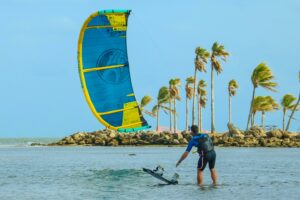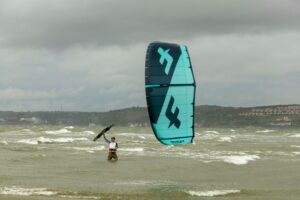This website uses cookies so that we can provide you with the best user experience possible. Cookie information is stored in your browser and performs functions such as recognising you when you return to our website and helping our team to understand which sections of the website you find most interesting and useful.
The control of kitesurfing is crucial for the navigation of the kitesurfer and its movements on the water.

Similar to other sailing sports such as sailing or windsurfing, the course of the kitesurfer is based on the wind.
However, there are specific techniques and peculiarities that distinguish the kitesurfing from other water sports.
The kitesurfer controls its course and speed by controlling the screen and the board.

The umbrella, also known as the kite, is controlled via the bar, which enables the kitesurfer to position the umbrella in the windscreen and thus determine the course for the wind. By adapting the position of the bar and the kite, the kitesurfer can make changes of direction.
At the beginning of the learning process, driving is on half wind courses. The kitesurfer moves diagonally to the wind direction. To change the direction, the surf moves the kite slowly along the wind windows. The shift in weight on the board plays a crucial role in holding the height and navigating on the water.
A special technique in kitesurfing is the tram tram neck, also known as Basic Jibe. The kitesurfer stops briefly before continuing his journey in the other direction. In contrast, a carved neck enables the kitesurfer to drive a semicircle before continuing his journey in the new direction. When carving, the focus is on a stronger edge guide, similar to skiing.
There are also differences depending on the kiteboard used. While no actual turn is possible with a Twin Tip, a directional board allows the kitesurfer to actually turn it by stopping and then continuing in the new direction.
The control of kitesurfing requires skill, sensitivity and understanding for the movements of the wind and water. Through continuous training and experience, a kite surfer can refine his technology and develop a higher level of control over his journey.
Starting the Kite

The procedure for starting the umbrella depends on the system used. A start helper makes sense for tubkite.
He holds the umbrella on the edge of the windscreen, where the umbrella does not develop as much train, so that the athlete can fly the umbrella safely into the zenith. Without a start helper, the umbrella can be held on the floor on a handled umbrella corner with sand or sandbags.
At the start, the sandbags are thrown off by train on the linen in question and the umbrella rises to the sky.
Certain RAM-AIR umbrellas can also be started without helpers.
If possible, these dragons should not be started in the direct performance zone – unless the wind is below 3 BFT.
For safety reasons, however, a helper is also advisable for these umbrellas who preserved the athlete from being pulled forward unintentionally. This also applies to the start of the tube kite, especially in extremely much wind.
Water Start when Kitesurfing
After a water landing of tube umbrellas, in which the kite is mostly wrong, the kitesurfer tries to turn the dragon onto the “back” by targeted movements, that is, the top of the screen, which normally lies on the water. This is done by relieving the front linen, while the kitesurfer swims towards the screen. By control movements on the control lines, the umbrella is carefully moved from the performance zone to the windscreen edge. There the umbrella can be restarted by train on the tax leash. Systems with a fifth leash on the front hose simplify this process and enable a safer start of water.

If the umbrella is wrong, a so -called backward start can be carried out if the screen is designed accordingly. Matt coils can be started backwards by pulling on the baking lines. The umbrella then lifts backwards and can be brought back into the forward position through an 180 ° rotation. Some tube umbrellas have special linen systems that enable reverse flying. Backwards start systems are particularly advantageous for use in the country, for example on snow.
Bow umbrellas have an arched main tube, which means that the umbrella no longer lies completely on land or water. This makes it easier to restart because the umbrella can move onto the “back” to the windscreen without direct laying on and climb up again. The transition from the power zone is faster and softer.
Delta shape kites are currently characterized by their excellent water start properties. As soon as they lie on the water or snow, drive to the windscreen edge and can be started out of the water by pulling on the corresponding control line. These kites offer an efficient and reliable method for starting water during kitesurfing.
Jump while kitesurfing

The athlete reaches impressive heights during kites surfing and performs spectacular jumps, which are made possible by skillful manipulation of the kite.
A jump is initiated by moving the kitesurfer the kite into the other wind windside edge during the journey over the zenith.
By boosting the kite, the athlete is finally raised in the air, which enables jumps of over 10 meters – sometimes even flights.
In order to maintain a stable direction of flight during the jump, the athlete takes up a compact attitude and builds up a high body tension.
The landing takes place by slowly reducing the dragon into the original wind windside edge.
There are different types of jumps and tricks that can be carried out when kite surfing:
Basic Jump or Air:
This is a simple jump that often serves as the basis for further tricks. With particularly high or wide jumps, one also speaks of Big Air.
One-Foots:
Here the kitesurfer loosens a foot from the binding or loop and at the same time performs a trick, such as a grave trick or a flip trick. A pure one-foot is rarely carried out because there is a risk of losing the board in the air.
Board-offs:
With this technique, the kitesurfer increases with both feet from the bonds or loops and leads a trick, mostly in combination with a grave trick or a flip.
Flip-tricks:
These tricks contain rotations of the kitesurfer around his own axis, either horizontal (360 flip) or vertical (front flip or back flip).
Grave tricks:
Here the kitesurfer reaches for his board during the jump and at the same time performs other tricks. There are a variety of ways of illustrating the diamond diagram.
Ralys:
A special kind of jump in which the kitesurfer is only connected to the kite by the security lines (he drives “unhooked”). The kiter triggers the bar from the trapeze, stretches out its arms and brings the board over head height. The landing requires precise timing and control.
The variety of jumps and tricks in kitesurfing enables the athletes to continuously improve their skills and to live out their creativity.
Picture: Pexels harold-granados – Fuca Jaz
Kitesurfen Start -apg-graphics
water start when kiting pexels serk alesen
Jump while kiting

